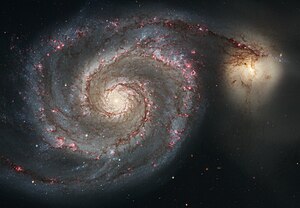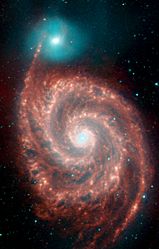Whirlpool galaxy
| Galaxy whirlpool galaxy |
|
|---|---|

|
|
| The Whirlpool Galaxy and Companion, captured by the Hubble Space Telescope | |
| AladinLite | |
| Constellation | Hunting dogs |
|
Position equinox : J2000.0 , epoch : J2000.0 |
|
| Right ascension | 13 h 29 m 52.7 s |
| declination | + 47 ° 11 ′ 43 ″ |
| Appearance | |
| Morphological type | SA (s) bc pec; HIISy2.5 |
| Brightness (visual) | 8.1 likes |
| Brightness (B-band) | 8.9 likes |
| Angular expansion | 11.2 ′ × 6.9 ′ |
| Surface brightness | 12.7 mag / arcmin² |
| Physical data | |
| Redshift | (+1544 ± 10) · 10 −6 |
| Radial velocity | 463 ± 3 km / s |
|
Stroke distance v rad / H 0 |
(25 ± 2) x 10 6 ly (7.54 ± 0.54) Mpc |
| Dimensions | approx. 160 billion visible M ☉ |
| diameter | 80,000 ly |
| history | |
| discovery | C. Messier |
| Discovery date | October 13, 1773 |
| Catalog names | |
| M 51 • NGC 5194 • UGC 8493 • PGC 47404 • CGCG 246-008 • MCG + 8-25-12 • IRAS 13277 + 4727 • 2MASX J13295269 + 4711429 • Arp 85 • VV 403 • GC 3572/3574 • H I 186 • h 1622/1623 • KPG 379 • Bode 25 | |
The Whirlpool Galaxy (also known as the Vortex Galaxy , Messier 51, or NGC 5194/5195 ) is a large spiral galaxy in the constellation Hounds . It is of the Hubble type Sc, that is, with a clearly pronounced spiral structure. M 51 has an apparent magnitude of 8.4 mag and an angular extent of 11.2 '× 6.9'. The distance from our Milky Way is about 25 million light years , but there are also deviating results between 15 and 37 million light years.
M 51 has a close, interactive companion. In the NGC catalog it bears the number NGC 5195 (M 51 itself has the number NGC 5194). The companion galaxy is of an irregular type, has an angular extent of 5.9 ′ × 4.6 ′ and a brightness of 9.6 mag. The core of the companion, however, has almost the same surface brightness as M51, so that both are hardly distinguishable in small telescopes.
Halton Arp organized his catalog of unusual galaxies into groups according to purely morphological criteria. This galaxy belongs to the class spiral galaxies with a large companion of high surface brightness on one arm (Arp catalog) .
An exceptionally active star formation is currently taking place in M 51, presumably caused by the tidal interaction with NGC 5195. This is why the galaxy has a high proportion of young and massive stars, which, however, will only be comparatively short-lived at a few million years. Three supernovae were observed in M 51 within 17 years : SN 1994I in April 1994, SN 2005cs in June 2005 and SN 2011dh in May / June 2011. Two supernovae marked the end of such massive stars as explosions of type Ic and type II .
M 51 is also interesting because it is one of the closest galaxies with an active galactic core , a Seyfert galaxy of type II. In its center there is a supermassive black hole .
discovery
The galaxy was discovered on October 13, 1773 by the French astronomer Charles Messier and was added to his catalog of diffuse objects with the number 51 . In 1845 the Irish astronomer William Parsons was the first to recognize the spiral structure of the object with his Leviathan giant telescope, which had just been put into operation .
The galaxy in different spectral ranges
The galaxy has been studied in depth using various methods due to its brightness and the multitude of interesting phenomena. In the X-ray range one can clearly see the companion galaxy, whereas of M 51 only the core is just as bright. Various mechanisms are responsible for this. The core of M 51 is bright because, as an active galactic core, numerous collisions between gases take place in it, i.e. stellar winds , expanding supernova remnants , and the accretion of matter into the central black hole. The X-rays of the companion, on the other hand, probably originate from the coronae of the numerous stars of the spectral type of the sun and later spectral types. In contrast, the ultraviolet spectral range is dominated by the spiral arms of M 51. This is due to the fact that there are active star formation areas and therefore many young stars of earlier types, i.e. particularly hot stars, exist that radiate strongly in the ultraviolet. The star formation area in the spiral arm between M 51 and the companion can be seen particularly clearly. The stars of the companion galaxy, on the other hand, are practically invisible in this spectral range .
In visible light , the contributions of the different stars are balanced, but you can also see from the rather reddish color of the companion that there are hardly any early spectral types. The gas nebulae , usually H-II areas , which are dominated by the pink light of the hydrogen lines Hα to Hδ, are clearly enhanced in contrast, they would not be so striking to the eye. These nebulae match the brighter ultraviolet regions very well, which is because the Balmer series hydrogen lines glow because the nebulae are excited to glow by the ultraviolet light from the young stars. In the near infrared , however, the distribution of the stars of later spectral types can be seen, which are only a few 1000 Kelvin hot. Individually, they are not as bright as the stars of earlier types, but they are much more numerous. Finally, in the mid-infrared the distribution of the interstellar dust in the galactic disk can be seen at various temperatures of a few hundred Kelvin. For example, the band of dust in the spiral arm at the bottom left, which absorbs visible light, appears dark in front of the spiral arm, while it glows in the mid-infrared itself. The small star formation area located there, clearly visible in the ultaviolet and in the visual on the nebula, is also apparent in the dust as a little warmer than the surroundings.
In the radio area , which is not shown here, gas clouds again determine the image, but those with neutral gas and molecules , whereby the radiation from different emission lines is also distributed very differently, thus allowing conclusions to be drawn about the temperature and density of the gas. In addition, the active core is clearly visible there. The companion in the radio band is again significantly darker than M 51 itself, since radio radiation is hardly emitted by the late-type stars that occur there, apart from the wind of individual AGB stars or the dust.
The active core
The bright region surrounds the active core of the galaxy. In the picture of the whole galaxy above, this region is only a few pixels in size in the center of the spiral. At a distance of 30 million light years, this region is about 120 light years in diameter. The dark band that can be seen in the picture is a torus of dust, which we are looking at almost exactly from the side. In the better and better images, a light core became visible immediately next to the dark band. The nucleus was originally assumed to be behind the torus, but today it is assumed that this point was used to localize the actual nucleus. This point, which is less than 5 light years in diameter, has about one million solar luminosities, the entire center about 100 million. A few hundred light-years away from the core, outside the image, there is a star-forming region that is unusual in such proximity to the core and is also attributed to the influence of the companion.
observation
M 51 is an interesting object for amateur astronomers. In any case, a telescope is necessary for observing the galaxy, or at least large binoculars with an oversized opening. Observation in the city is next to impossible, the best thing to do is to look for a location without light pollution . If the opening of the telescope is smaller than 10 cm, only an elongated spot can be seen. The spiral arms can only be observed at openings of 20 cm and more. With the help of astrophotography, it is even possible to scan the H-II regions and see dark plumes of dust.
Web links
- M 51: Calar Alto observatory
- M 51 at SEDS
- Spektrum.de : Amateur photos [1] [2]
- ARP ATLAS OF PECULIAR GALAXIES
- Seligman Arp
literature
- Jeff Kanipe and Dennis Webb: The Arp Atlas of Peculiar Galaxies - A Chronicle and Observer's Guide , Richmond 2006, ISBN 978-0-943396-76-7
Individual evidence
- ↑ a b c d e NASA / IPAC EXTRAGALACTIC DATABASE
- ↑ a b c SEDS NGC 5194
- ↑ K. Takáts, J. Vinkó: Distance estimate and progenitor characteristics of SN 2005cs in M51. In: Monthly Notices of the Royal Astronomical Society. Vol. 372, No. 4, pp. 1735 ff. (2006), bibcode : 2006MNRAS.372.1735T .
- ↑ ESO
- ↑ Seligman
- ↑ SEDS NGC 5195








